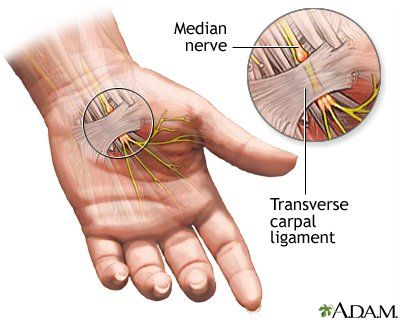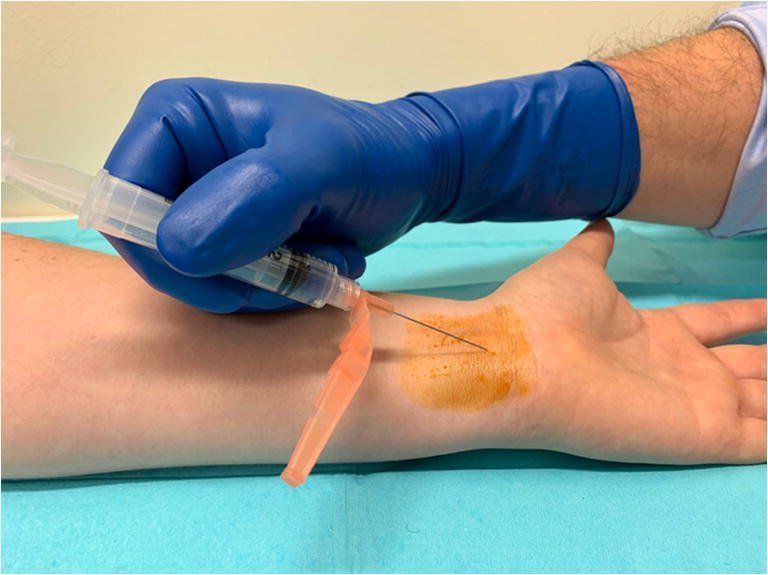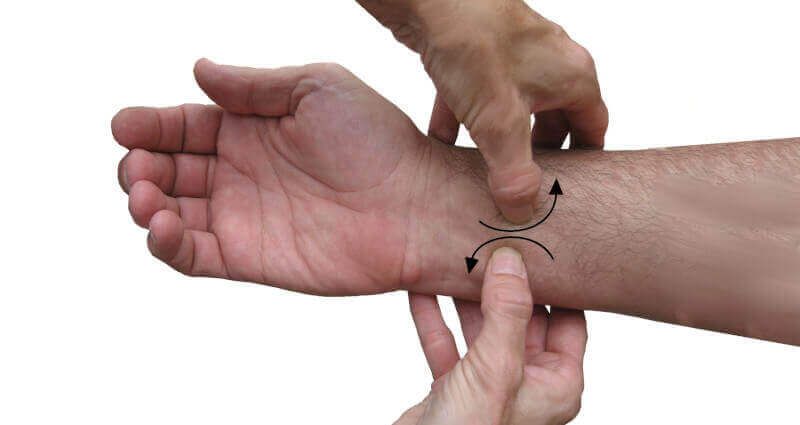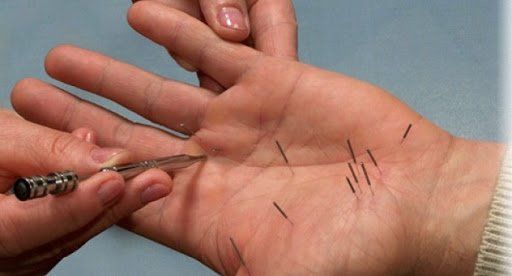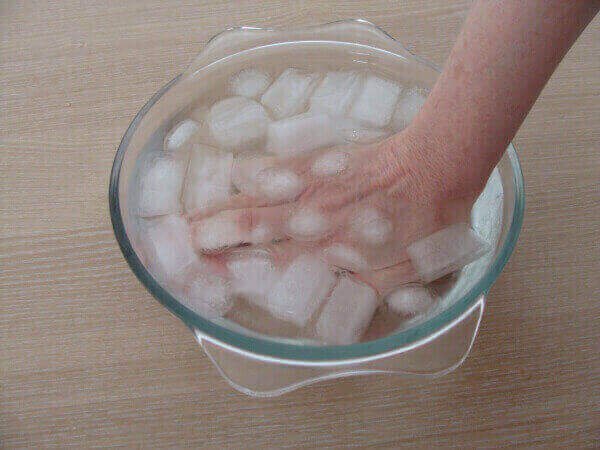How is Carpal Tunnel Treated?
From Dr. Z - Carpal tunnel syndrome specialist
How is Carpal Tunnel Treated?
When someone asks, "How is carpal tunnel treated?" they usually get the response, "With surgery." But that's not the complete answer. Certainly, many people opt for carpal tunnel release surgery to get rid of symptoms. But most people don't.
In fact, well over 80% of people treat this painful disorder of the hand and fingers using non-surgical therapies. These are well-established and generally quite effective - but only when properly used.
Actually, many such "non-operative" therapies usually get better results than surgery when two or more are used in combination. This is why doctors and the American College of Orthopedic Surgeons recommend first trying all of the non-surgical therapies listed below before considering surgery.
This article outlines both surgical and non-surgical options to treat carpal tunnel syndrome.
What is carpal tunnel?
Carpal tunnel syndrome (most times, simply called carpal tunnel) affects 5 million Americans. It's also the leading musculoskeletal disorder of the upper extremities.
Carpal tunnel usually starts out slowly. You first notice a problem because you might wake up during the night with a numb hand or fingers. Generally it starts off in one hand. But by 6 months, signs and symptoms usually appear in the other hand as well. This is called bilateral carpal tunnel syndrome.
In time, and as the condition progresses, symptoms also begin to appear during the daytime. They generally will arise when your hand is at rest. This distinguishes carpal tunnel from wrist tendonitis, which is only painful when your hand is working.
Take this quick self-test to see if you have carpal tunnel syndrome or wrist tendonitis.
The signs and symptoms of carpal tunnel syndrome are relatively straight-forward. They focus on the palm of the hand and the fingers (except the little finger). These symptoms are:
- Numbness
- Pain
- Tingling (pins & needles)
- Burning
- Itching
- Puffy feeling
- Shooting electric shocks
- Weakness
- Loss of grip strength
- Clumsiness
What causes carpal tunnel?
The causes of carpal tunnel syndrome are many. But all causes have one thing in common. That is, they produce swelling inside your wrist joint. That swelling results in extreme pressure within the joint.
Your median nerve passes through the wrist joint on its way from your fingers and hand. So any pressure build-up in the joint will exert pressure on the nerve as well. It's that pressure on the median nerve that causes all of the distressing signs and symptoms of carpal tunnel syndrome.
But what causes the swelling (inflammation) to begin with? Scientists don't know exactly why it happens. But we do know swelling occurs under certain conditions. These are called risk factors. It means you have a higher probability of getting carpal tunnel if you have one or more of these conditions:
- Pregnancy
- Being female
- A family history of the disorder
- History of rheumatoid arthritis
- Over 70 years old
- History of diabetes
- Obesity
- Having a small frame
- Being emotionally stressed
- Having a high risk job (see below)
Who gets carpal tunnel?
The CDC and NIH have identified jobs most closely associated with getting carpal tunnel syndrome. In most cases, these jobs or industries have more than 6 times the average reported cases of carpal tunnel. They are:
- Graphic designers
- Housekeepers
- Dental hygienists
- Sewers and knitters
- Radiologists
- Transcriptionists
- Musicians
- Farmers
- Fine artists
- Hairdressers
- Assembly line workers
- Data-entry clerks
- Truck drivers
- Horse riders or trainers
How is carpal tunnel treated?
There are 2 basic ways carpal tunnel is treated: surgery and non-surgical therapies (also called "non-operative" or "conservative" methods).
Most people opt for the non-surgical options first. That's because they work well for most people, even with severe symptoms. If a patient uses non-surgical therapies without success, then surgery is always another option.
How is carpal tunnel treated with surgery?
All surgery to relieve carpal tunnel symptoms is called "carpal tunnel release surgery". The "release" means that the median nerve is released from being crushed (or "entrapped") by the pressure inside the wrist joint.
In order to relieve the pressure, the surgeon must cut a ligament holding your wrist bones together. When it's cut, the bones snap apart, making more room for the median nerve.
The complications rate of carpal tunnel surgery is 3-25%. The failure rate (as measured by patient satisfaction 2-3 years after surgery) is approximately 57%.
The surgeon can release the median nerve using one of two basic types of surgery;
open
or
endoscopic
carpal tunnel release surgery. Anyone considering surgery should sit down with their doctor and discuss the various
pros and cons of carpal tunnel release surgery.
Open carpal tunnel release surgery
The most common type of carpal tunnel release surgery is the open technique. That means the doctor makes a 2-3 inch long incision in your lower palm. This lets the surgeon clearly identify the ligament in order to cut it.
The great advantage of this technique is that the surgeon can clearly see the ligament and other important structures. This way, the surgeon avoids inadvertently damaging the median nerve, its branches, or even a blood vessel or ligament. Doing so leads to complications and extends recovery time.
The disadvantage of the open technique is that it results in more postsurgical pain and longer recovery time. Also, more attentive aftercare is required due to the larger incision. Of course, the resulting surgical scar is much larger.
Endoscopic carpal tunnel release surgery
In a similar way, endoscopic carpal tunnel release surgery aims to cut the same ligament in order to relieve pressure on the median nerve. But instead of a long incision on the palm, the doctor uses an endoscope to look inside the wrist joint.
The doctor makes one tiny incision in your palm for the endoscope, which also contains the scalpel. Sometimes two holes are needed; one for the endoscope and a separate one for the scalpel. These are called the single portal and double portal endoscopic methods, respectively.
The great advantage of endoscopic carpal tunnel release surgery is the use of a smaller incision (or incisions). That means less trauma to you hand. It results in much less post-surgical pain, less complicated aftercare, and faster recovery time.
The disadvantage of this technique is the greater chance the doctor can accidentally cut or damage an important structure. That's because of the more limited field of view offered by the endoscope.
How is carpal tunnel treated non-surgically?
The non-surgical or non-operative ways to treat carpal tunnel are many. Most doctors and scientists suggest using more than one method simultaneously for maximum symptoms relief.
That means even severe symptoms will be eliminated (partially or completely) within 6 weeks. The most common methods are:
- Steroid injections
- Plain old rest
- Myofascial release massage
- Pain medicines
- Night bracing
- Stretching exercises
- Acupuncture
- CBD oil
- Yoga
1. Steroid injections
Cortisone injections (or steroid shots) are used to reduce inflammation inside the wrist joint. Once inflammation is reduced, the pressure on the median nerve is eliminated and symptoms disappear.
To inject the steroid, first the doctor cleanses the area at the wrist joint. Then, using a hypodermic needle, injects the steroid solution into the writ joint. Some people feel relief almost immediately. Others may take up to a couple weeks to feel relief. Unfortunately, about 55% of patient feel nothing whatsoever. The failure rate is also proportional to the severity of symptoms.
Usually (when the shots are as success) symptoms will return within 6 months. The reasons for this are unknown.
2. Plain old rest
Never underestimate the power of rest. If you take the opportunity to have rest breaks for your hand and fingers while they work, it increases the chances your symptoms will spontaneously resolve.
In fact, it's estimated that 28-60% of patient will recover spontaneously with just simple rest. This also means avoiding the activity that's causing your carpal tunnel symptoms to begin with. Therefore, rest and avoidance will usually greatly improve the pain or numbness of carpal tunnel syndrome.
3. Myofascial release massage
This non-surgical method is mysterious to most patients. But it's used by just about every therapist and chiropractor to relieve carpal tunnel syndrome. It's also been around since antiquity.
Myofascial release massage is a specialized technique that requires "kneading" the tissues over your wrist joint. The kneading action loosens restrictions and adhesions which cause inflammation and swelling. The result is that fluid pressure drains away. And the effect of this massage therapy on carpal tunnel is permanent.
Myofascial release massage is effective in over 90% of patients. But the downside is that it must be performed daily for 30 days to see good results.
Note: The CarpalRx performs this same massage automatically, and with the same rate of effectiveness..
4. Pain medicines
The most common and effective over-the-counter pain medicines are called NSAIDs (non-steroidal anti-inflammatory drugs). They include Tylenol, Advil, Motrin, and Aleve. They're great for temporarily relieving the pain of carpal tunnel syndrome. But they do little for the numbness, tingling or weakness symptoms.
These medicines work by reducing inflammation. That, in turn, reduces pressure on the median nerve. But the effects of these drugs wear off in a few hours. Worst of all, they are not intended for long term use. That's because of the risk of damage to your liver and kidneys after using them continuously for more than a month.
5. Night bracing
After resting, perhaps the simplest thing you can do that's also very effective against carpal tunnel is night bracing. It's especially effective when used in combination with other non-surgical remedies like myofascial release massage and stretching exercises.
We all unconsciously bend our wrists backward when we sleep. This is very bad if you have carpal tunnel syndrome. Backward wrist bending increases pressure on your median nerve.
But a night brace keeps you hand in a neutral (straight) position. However, not just any brace will help. You must use a certified carpal tunnel night brace. (They are not usually sold in pharmacies like CVS, Walgreens or Walmart.) Regular pharmacy wrist braces have a metal spine on the palm's surface. This spine presses into your wrist, damaging tissues beneath. Most people who wear the wrong brace wake up in the morning with worse symptoms.
But a certified carpal tunnel night brace has the spine either on top or on the side of your hand. This prevents tissue damage inside the wrist joint.
6. Stretching exercises
When asked, "How is carpal tunnel treated?" few doctors neglect to recommend stretching exercises. Just as night bracing is a simple therapy, so are stretching exercises - and they're just as effective (perhaps more so).
The caveat is that you need to do the proper stretching exercises. Carpal tunnel stretching exercises target your flexor tendons. These are the structures which become irritated and inflame (swell). So the proper stretches help reduce irritation by clearing adhesions and restrictions.
These exercises only take 30 seconds to perform. That means you can do them every hour without taking a significant break from work. A dedicated daily regimen of hourly carpal tunnel stretching exercises can eliminate even the most severe symptoms.
But for such severe symptoms, it's best to use stretching exercises in combination with night bracing and myofascial release massage. When doing so, usually symptoms will disappear within 6 weeks.
7. Acupuncture
The range of acupuncture's effectiveness is wide. Some patients say it doesn't work at all while others claim it to be miraculous. This highlights the fact that scientists still don't understand the dynamics of this ancient therapy.
We know that acupuncture unblocks nerve impulses that send pain information to the brain. It also releases pain relieving chemicals. But how these properties relate to relieving carpal tunnel syndrome is unknown.
We do know that the number of acupuncture sessions required for pain relief depends on your severity and how long you've had carpal tunnel. Generally, most people require three weekly sessions for about ten weeks. Usually pain returns within a few hours to days after a session. Acupuncture is not considered a long-term therapy for carpal tunnel syndrome.
8. CBD oil
CBD or “cannabidiol” oil is extracted from the marijuana plant. This is s curious product. There are few scientific reports of it's effectiveness. But there is widespread anecdotal evidence that it works for a number of disorders, including carpal tunnel. Just ask any doctor who will likely say, "CBD works, but I don't know how."
A clue comes from data showing that CBD has anti-inflammatory properties. Also, CBD acts on pain receptors which are activated with inflammation. And since the basis of carpal tunnel syndrome is inflammation inside the wrist joint, the connection appears valid.
In almost every case, the oral form of CBD seems to work best. The topical (cream) form appears to be less effective.
9. Yoga
You might be surprised to learn that yoga has been proven in multiple medical trials to help with carpal tunnel syndrome. The clinical trials come after decades of anecdotal reports of yoga's success with carpal tunnel.
Practitioners claim long-term carpal tunnel pain relief with yoga exercises. They recommend performing the yoga exercises at least twice a day until symptoms disappear.
What NOT to do
Many people ask doctors about this therapy or that product. Some only provide temporary pain relief. Others don't work at all. Here are the therapies you should not waste your time on, and why.
- Ice & contract baths: Ice baths and contrast baths (switching between warm and cold water) work to relieve pain - but the effect is only temporary. A few minutes after removing your hand from the bath, symptoms return.
- Adhesive tape products:
Several products are sold to relieve carpal tunnel which are merely adhesive tape. You apply the tape somewhere on the skin of your hand. But carpal tunnel syndrome is a problem
inside
your wrist joint. Nothing you do to your hand's skin can change (or help) that.
- Topical creams: Products such as Biofreeze merely irritate the upper layers of the skin. That irritation is interpreted by the brain as coldness. This creates a powerful placebo effect, making you believe the pain is dissolving. But the placebo effect wears off within a couple hours.
- Vitamin B supplements: Anecdotal reports of vitamin B supplements helping carpal tunnel patients abound. But every scientific study performed to determine it's effectiveness has shown that it's no better than a placebo.
- Homeopathic medicines: Don't waste your money. All homeopathic medicines are a public scam and simply do nothing at all. The FDA is already cracking down on these homeopathy manufacturers.
- Herbals: Herbal products like St. John's Wort, frankincense, myrrh, cinnamon, eucalyptus, geranium, peppermint, and arnica are used by patients worldwide. But they don't work in the least for carpal tunnel syndrome.
Conclusion
The answer to, "How is carpal tunnel treated" can be answered simply: surgically and non-surgically. Surgical options use the open or endoscopic carpal tunnel release methods. But over 80% of people use non-surgical options with the same (or better) success rate as surgery. Usually, two or more non-surgical methods work best, especially if symptoms are severe.








